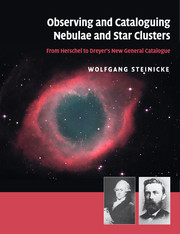Book contents
- Frontmatter
- Contents
- Preface
- 1 Introduction
- 2 William Herschel's observations and parallel activities
- 3 John Herschel's Slough observations
- 4 Discoveries made in parallel with John Herschel's Slough observations
- 5 John Herschel at the Cape of Good Hope
- 6 The time after Herschel's observations until Auwers' list of new nebulae
- 7 Compiling the General Catalogue
- 8 Dreyer's first catalogue: the supplement to Herschel's General Catalogue
- 9 Compilation of the New General Catalogue
- 10 The New General Catalogue: publication, analysis and effects
- 11 Special topics
- 12 Summary
- Appendix
- References
- Internet and image sources
- Name index
- Site index
- Object index
- Subject index
6 - The time after Herschel's observations until Auwers' list of new nebulae
Published online by Cambridge University Press: 06 December 2010
- Frontmatter
- Contents
- Preface
- 1 Introduction
- 2 William Herschel's observations and parallel activities
- 3 John Herschel's Slough observations
- 4 Discoveries made in parallel with John Herschel's Slough observations
- 5 John Herschel at the Cape of Good Hope
- 6 The time after Herschel's observations until Auwers' list of new nebulae
- 7 Compiling the General Catalogue
- 8 Dreyer's first catalogue: the supplement to Herschel's General Catalogue
- 9 Compilation of the New General Catalogue
- 10 The New General Catalogue: publication, analysis and effects
- 11 Special topics
- 12 Summary
- Appendix
- References
- Internet and image sources
- Name index
- Site index
- Object index
- Subject index
Summary
In 1841 Wilhelm Struve wrote that ‘The study of the nebular heaven seems to be the exclusive dominion of the two Herschels.’ Thus the following question arises: was there still anything to discover after the intensive observations of William and John Herschel? The clear answer is yes – for several reasons. First, the two Herschels had not completely surveyed the sky. Their sweeps left remarkable gaps, especially at high declinations and at greater distances from their reference stars. Moreover, new and better telescopes were available in the post-Herschel era, revealing much fainter objects. Finally, new campaigns were started, in which many visual observers (normally professionals) participated. Though their targets were mostly comets and minor planets, many new nebulae were found accidentally. For the search small refractors with great light-gathering power were used: the typical comet-seeker was optimal for observing large, faint nebulae too. Larger telescopes with apertures of 10–30 cm were needed to trace a comet or to create ‘ecliptical charts’ showing stars down to 13 mag – such charts were important tools by means of which to identify minor planets. Using them, occasionally faint non-stellar objects could be detected.
By virtue of these observations, the number of new nebulae slowly increased from 1845. Some discoverers published lists, but there were at first no new compilations. John Herschel's Slough catalogue was the primary reference to check the identity of objects.
- Type
- Chapter
- Information
- Observing and Cataloguing Nebulae and Star ClustersFrom Herschel to Dreyer's New General Catalogue, pp. 88 - 187Publisher: Cambridge University PressPrint publication year: 2010



